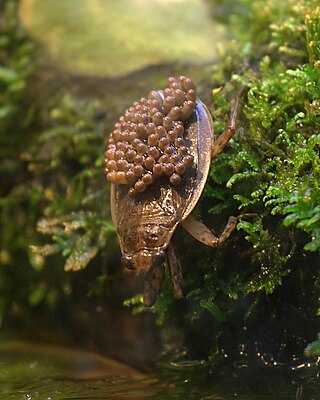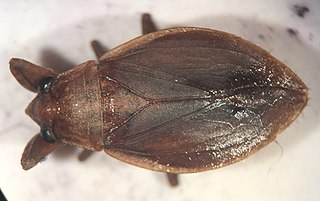
Belostomatidae is a family of freshwater hemipteran insects known as giant water bugs or colloquially as toe-biters, Indian toe-biters, electric-light bugs, alligator ticks, or alligator fleas. They are the largest insects in the order Hemiptera. There are about 170 species found in freshwater habitats worldwide, with more than 110 in the Neotropics, more than 20 in Africa, almost as many in the Nearctic, and far fewer elsewhere. These predators are typically encountered in freshwater ponds, marshes and slow-flowing streams. Most species are at least 2 cm (0.8 in) long, although smaller species, down to 0.9 cm (0.35 in), also exist. The largest are members of the genus Lethocerus, which can exceed 12 cm (4.5 in) and nearly reach the length of some of the largest beetles in the world. Giant water bugs are a popular food in parts of Asia.

Lethocerus indicus is a giant water bug in the family Belostomatidae, native to South and Southeast Asia, as well as southeast China, the Ryukyu Islands, and New Guinea. It was originally described as Belostoma indicum but is no longer placed in that genus.

Lethocerus deyrollei is a species of giant water bug that traditionally is included in the genus Lethocerus, although recent authorities place it in the monotypic Kirkaldyia. They are large, predatory and nocturnal insects. They are one of the best known giant water bugs and are found in Japan, Korea, east China, east Indochina and the Amur region of Russia. They are very common in much of their range, but have declined drastically in some regions and are considered threatened in Japan and Korea. They live in still waters with vegetation, hatching in the summer months and then overwintering half a year later as adults. They primarily feed on small fish, amphibians and aquatic insects, but have also been recorded taking water snakes and young turtles.

Lethocerus is a genus of the hemipteran family Belostomatidae, known colloquially as giant water bugs, toe biters and electric light bugs, distributed in tropical, subtropical and temperate areas of the world. The greatest diversity of species occurs in the Americas, with only a single species in Europe, two in Africa, two in Australia and three in Asia. It includes the largest true bugs with species capable of reaching a length of over 12 centimetres (4.7 in). The South American L. grandis and L. maximus are the only species to commonly exceed 9 cm (3.5 in), with more typical lengths for the remaining species being between 4.5 and 9 cm. Lethocerus sp. are distinguished from other genera in the Lethocerinae by two symmetrical furrows in the inner pad of setae on the fore femur, the external borders of parasternites II and III narrowed and nearly straight, and with the setae of the tarsomeres following the line of the tibial setae.

Lethocerus americanus, sometimes called the electric light bug, toe biter or fish killer, is a giant water bug in the family Belostomatidae, native to southern Canada and the United States. It typically has a length around 5–6 cm (2.0–2.4 in). It was originally classified as a species in genus Belostoma.

Abedus is a genus of giant water bugs found in freshwater habitats in southern United States, Mexico and Central America. Sometimes called ferocious water bugs, these brown insects typically are between 2.3 and 4 cm (0.9–1.6 in) long, although A. immaculatus only is about 1.3–1.4 cm (0.51–0.55 in), making it the smallest North American belostomatid and possibly worthy of separation in its own genus. Otherwise the different Abedus species are very similar and can often only be separated with a microscope. They will bite in self-defense, which is painful but not dangerous.

Lethocerus insulanus is a species of giant water bug of the family Belostomatidae. Its common name is the Australian giant water bug, but it is also called the electric light bug or giant fishkiller. These names are also used for various other members of the family, including the other Australian species, L. distinctifemur, which is similar to L. insulanus.

Lethocerus patruelis is a giant water bug in the family Belostomatidae. It is native to southeastern Europe, through Southwest Asia, to Pakistan, India and Burma. It is the largest European true bug and aquatic insect. Adult females are typically 7–8 cm (2.8–3.1 in) long, while the adult males are 6–7 cm (2.4–2.8 in).

Belostoma is a genus of insects in the hemipteran family Belostomatidae, known colloquially as giant water bugs. Members of this genus are native to freshwater habitats in the Americas, with the greatest species richness in tropical South America. Most species in the family Belostomatidae have historically been included in Belostoma, but several of these have been moved to other genera. 9 species are claimed to be found in Northern America, but the genus Belostoma is actually divided into 16 subgroups containing about 70 species.

Hebrus is a genus of velvet water bugs in the family Hebridae. There are at least 160 described species in Hebrus.

Tingis is a genus of lace bugs in the family Tingidae. There are at least 130 described species in Tingis.
Phytocoris rubrimaculatus is a species of plant bug in the family Miridae. It is found in North America.

Aneurinae is a subfamily of flat bugs in the family Aradidae. There is at least 1 genus, Aneurus, in Aneurinae.

Abedus herberti, the toe biter or ferocious water bug, is a species of giant water bug in the family Belostomatidae. It is native to streams, especially in highlands, in Arizona, New Mexico and Utah in the United States and in northwestern Mexico. Adults are typically 2 to 4 cm (0.8–1.6 in) long. The species is flightless, but may move overland between water sources. It will bite in self-defense, which is painful but not dangerous.

Lethocerus uhleri, or Uhler's water bug, is a species of giant water bug in the family Belostomatidae. It is found in eastern North America from New York, Michigan, and Wisconsin south to Florida and northern Tamaulipas.

Aquarius conformis is a species of water strider in the family Gerridae. It is found in eastern North America from Quebec west to Wisconsin and south to Florida and Mexico.
Belostoma testaceum is a species of giant water bug in the family Belostomatidae. It is found in the eastern United States from New York south to southern Florida and west to Texas and Michigan.

Lethocerus medius is a species of giant water bug in the family Belostomatidae. It is found in Central America from northern Panama north throughout Mexico to southern Arizona, New Mexico, and Texas in the United States, and Cuba, Jamaica, the Cayman Islands, and the Bahamas.

Abedus immaculatus is a species of water bug in the family Belostomatidae. It is the only Abedus species found in the eastern United States, occurring throughout Florida north into Georgia and west along the Gulf Coast to Mississippi.

Benacus is a genus of giant water bug in the hemipteran family Belostomatidae. Benacus is a monotypic genus, containing a single species, B. griseus, which is found in North America. Benacus was formerly considered a subgenus of Lethocerus.

















